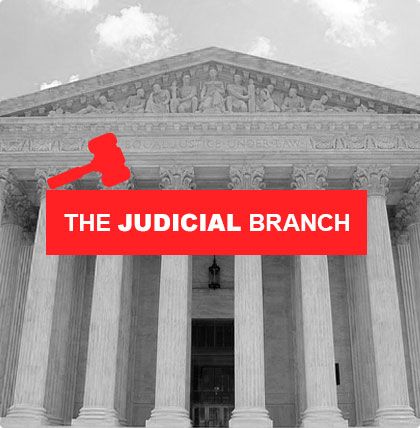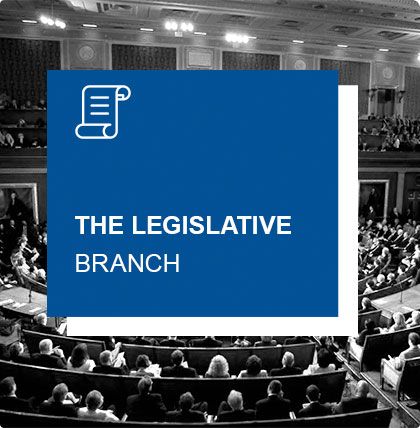The Legislative Branch of the U.S. Government
Established by the U.S. Constitution, the Legislative branch is the only arm of the government with powers to enact, repeal and amend laws or acts adopted and administered by governmental organizations. Laws are the foundation of the U.S. legal system and considered vital in maintaining a structure of modern society and prevent anarchy. Although laws serve to control human behavior, they also aim to protect society, ensure freedom, resolve conflicts, promote justice and equity among others.
Lawmaking is the core responsibility of the Legislature and it dispenses that responsibility in consonance with the other two branches of government, the Judiciary, and the executive branch while remaining very distinct from the other branches in its roles, functions, and powers under the constitution.
History of the U.S. Legislative Branch
Prior to the Constitutional Convention of 1787, the national legislature was made up of a single House, with an equal number of delegates from each state. After vigoroU.S. debates, representatives of varioU.S. states in attendance at the Constitutional convention eventually reached a compromise, also known as the Great Compromise. The Great compromise proposed a bicameral legislature with different levels of representation from each state in each Chamber.
The United States’ bicameral Legislature was created in 1789 under Article I of the Constitution, consisting of the Senate, and the House of Representatives. Both Houses or Chambers are described as the U.S. Congress with equal authority to enact legislation. The first members of the 2 Chamber Congress convened on March 4, 1789, during the first 2 years of President George Washington's tenure.
Congress is required to convene at least once a year and has done so since its establishment in different locations including the Federal Hall, New York between 1789 to 1790, the Congress Hall. Pennsylvania, from 1790 to 1799 and the Capitol in Washington D.C. since 1800.
Initially, the Constitution prescribed that such Congress meetings be held on the first Monday of December, this was changed to noon, January 3rd under the 20th Amendment, and the Congress may by law appoint another date. Members of Congress are chosen every 2 years and have Since 1789, passed more than 20,000 Acts or laws contained in the U.S. Statutes at Large.
What Are The Functions of Congress?
The main aim of the Constitution was to empower a Congress that reflected the will of the people and empowered the Congress with the most crucial power, making laws. However, the roles and responsibilities of Congress go beyond lawmaking, under the Constitution, Congress also has the power to
- Declare war
- Approve or reject a candidate presented for appointment by the President
- Try and impeach public officers
- establish the federal courts and their jurisdictions.
- regulate foreign and interstate commerce
- control taxing and spending policies
- pay the debts and provide for the common defense and general welfare of the United States.
- Approve or reject treaties negotiated by the executive branch
- Elect the President of there is a tie in the electoral college votes
- Oversight
- Investigate
What Are the Checks and Balances on Congress?
With such principal authority conferred by the Constitution, Congress is no doubt, a very powerful branch of government with great influence on the other branches and the society at large. No powerful organ of government is without checks and balances, including the Legislature, To prevent the concentration and abuse of powers, the Constitution creates a structure for a balanced legislature by creating two separate chambers of the legislature. Each chamber checks the other. No bill by one Chamber may be passed into law without the approval of the other.
The Executive branch may exercise veto power to stop a bill proposed for enactment by the legislature and unless both Chambers agree with popular support of 2/3 votes of both the Senate and the House, the Bill will fail to become legislation. The Executive branch may also use discretionary powers in affecting decisions relating to the establishment of military bases, building, and improvement of dams, highways and other actions within the provisions of the Constitution.
The Judiciary checks the legislature by reviewing laws passed by Congress and determining their alignment with the Constitution. The Judiciary may declare a law passed by the legislature unconstitutional.
How is the Legislature Organized?
The U.S. legislature consists of two Chambers, the Senate and the House of Representatives. Members of the House of Senate and House of Representatives are elected into office by direct elections rather than through an electoral college applicable to Presidential elections. Each voter casts their ballot for the person or party they want to see in either Chamber. Elections to the houses are conducted every two years
The Senate
The U.S. Senate, often described as the upper House of Congress, consists of 100 seats/ members. All 50 states are equally represented, 2 senators elected from each state. The Senate is described as a continuing body or the house that never dies because Senators serve a rotating 6-year/staggered term. Meaning, although elections into the Senate are conducted bi-annually, not all seats in the Senate are vacated or up for re-elections, only about 1/3 of the Senators are up for elections during the midterm elections. (Elections that take place halfway through a President’s four-year term). The system of rotation allows each State to retain at least one senator during elections unless there are other reasons why their seat is vacant.
Who Can Run for a Senate Position?
A person may be eligible to contest for a senatorial seat, under the constitution if they are
- at least 30 years of age,
- Have been a U.S. citizen for a minimum of 9 years
- resident in the State from which they are elected
What is the Vice President's Role in the Senate?
The Vice President is the Constitutional head of the Senate and casts the deciding vote whenever there is a deadlock/tie and the Senate could not reach a decision. The President Pro Tempore presides over the Senate whenever the Vice President is absent, which typically is often the case. The Senate leadership also includes the Majority leader, the minority leader, Whips, members of committees.
What is the Role of the President Pro Tempore?
The President Pro tempore is elected by Senate, able to speak and vote on any issues raised and for debate and is traditional, the member of the majority party with the longest record of continuoU.S. service.
Who are the Majority and Minority Leaders of the Senate?
The majority and minority leaders are senators elected by members of their parties to be lead speakers on their party’s position regarding the issues up for debate on the Senate floor. Their position as majority or minority leaders is dependent on the position of their party. The majority leader is usually the senator elected by the larger party and the elected spokesperson for the opposition party is designated as the minority leader.
The party floor leadership positions were not mentioned in the Constitution but the roles and responsibilities of the majority and minority leaders have evolved over time, including agreeing on a schedule for debate and amount of time assigned to each party to make their input, keeping their party informed on the legislative program, playing a vital role in the appointment of members of their party to committees, coordinating members of their party and party strategy, collaborating with Chairs of committees and ranking members, and so on. The majority leader represents both their party and the Senate as an institution. The majority leader is customarily given the priority to obtain the recognition to speak on the floor.
Who are the whips in the Senate?
Whips are assistant floor leaders and second-ranking officer in the senate. They may act as floor leaders in the absence of their party’s floor leader, Whips have the responsibility of keeping their party members in line, gather votes and support on major issues in line with their Party’s objectives.
What are Senate Committees?
Senate committees are established to oversee and handle specific governmental operations, identify policy problems, issues requiring legislative review conduct hearings, and handle technical and complex matters under their purview. Committees consist of members, a chairman (usually, a senator from the majority party) and ranking member form the minority party. The Committees are further divided into subcommittees to handle specific tasks within the huge volume and technical work of their Committee’s assigned areas and provide the Senate with reports on how to proceed on such issues. There are three main types of committees: standing committee, Joint Committee, and Special committee.
The Senate has Permanent Committees also known as standing committees, established by the Rules of the Senate. Senate Committees include
-
Agriculture, Nutrition, and Forestry
-
Appropriations
-
Armed Services
-
Banking, Housing, and Urban Affairs
-
Budget;
-
Commerce, Science, and Transportation;
-
Energy and Natural resources
-
Environment and public works
-
Finance
-
Foreign relations
-
Health, Education, Labor, and Pensions;
-
Homeland Security and Governmental Affairs
-
Judiciary
-
Rules and Administration
-
Small Business and Entrepreneurship
-
veterans' affairs
Select or Special Committees are established by separate resolution of the Senate and may be permanent or temporary. They focU.S. on issues that are outside the jurisdiction of the Standing Committees or on prominent issues that cut across the assigned roles of the varioU.S. committees. Special Committees include Aging, Ethics, Indian Affairs, and Intelligence. Joint Committees consist of members from both the Senate and the House of Representatives.
The House of Representatives
The House of Representatives, also known as the lower chamber of the legislature is comprised of varying interests from all the States. It is said to represent the people’s will since the Representatives must face re-elections every 2 years and remain answerable to the people of their Congressional Districts who chose to send them to the House with their votes. Congressmen and Congresswomen in the House represent Constituencies or districts within their State rather than the State as a whole. Each member of the House must be at least 25 years of age, a citizen of the U.S. for a minimum of 7 years and resident in the State from which they are elected, regardless of the constituency they are selected to represent.
Allocation of Congress seats is apportioned every 10 years following the decennial federal census, based on the population of each State, giving more clout to more populoU.S. states. Every state has at least 1 member, largely populated States like California send a higher number of representatives. The membership of the House has remained 435 since 1913.
Alaska, Delaware, Montana, North Dakota, South Dakota, Vermont, and Wyoming have 1 representative in the House representing their generally sparse population. Other states and the number of representatives are
- Alabama 7
- Arizona 9
- Arkansas 4
- California 53
- Colorado 7
- Connecticut 5
- Florida 27
- Georgia 14
- Hawaii 2
- Idaho 2
- Illinois 18
- Indiana 9
- Iowa 4
- Kansas 4
- Kentucky 6
- Louisiana 6
- Maine 2
- Maryland 8
- Massachusetts 9
- Michigan 14
- Minnesota 8
- Mississippi 4
- Missouri 8
- Nebraska 3
- Nevada 4
- New Hampshire 2
- New Jersey 12
- New Mexico 3
- New York 27
- North Carolina 13
- Ohio 16
- Oklahoma 5
- Oregon 5
- Pennsylvania 18
- Rhode Island 2
- South Carolina 7
- Tennessee 9
- Texas 36
- Utah 4
- Virginia 11
- Washington 10
- West Virginia 3
- Winsconsin 8
The speaker of the House of Representatives is the presiding officer and highest-ranking member of the House. Usually elected from the majority political party in the House, although there is no specific legal requirement that the Speaker must be a member of the majority political party. Both political parties in the House, Democrat, and Republicans nominate a candidate for elections The leadership of the House is elected every 2 years by a roll call vote on the first day of a new session, Customarily, in January. Roll call votes are repeated until one of the nominees obtains a majority of all the votes.
The Speaker plays a significant role in the House, including acting as the administrative head of the House, administering the Oath of office to newly elected congressmen and congresswomen, appointing the Chair and members of standing, select and special House committees. The speaker exercises their power to determine the House’s legislative agenda and also pushes the agenda of their party by ensuring that bills with support from the majority party are passed by the House.
Unlike the President pro Tempore (President for the time being) of the Senate, the Speaker of the House of Representatives is a de facto leader. In the line of Presidential succession, the Speaker is second to the Vice President and has the authority to assume the office of the President, if the position becomes vacant as a result of the death, physical incapacitation, removal or resignation the incumbent and Vice President is also unable or unfit to assume the office of the President.
The House also adopts a committee system in addressing complex legislative issues and achieving the House’s objectives. Each committee has its assigned roles and functions to efficiently dispense with the huge workload and complex nature of issues on which the House must legislate.
How does the legislature Make laws?
Before a bill becomes a law, it must go through varioU.S. stages of the legislative process. There are 4 basic types of legislation considered by Congress for enactment, Bill, Joint Resolutions, Simple Resolutions, and Concurrent Resolutions.
- Bills – laws or legislation proposed and introduced for possible enactment by the Legislature. To become a law, a bill must be approved by both the Senate and House of Representatives and signed by the President.
- Joint resolutions also require the approval of both Houses and the President to become laws.
- Concurrent Resolutions do not become laws but must be passed by the 2 Chambers.
- Simple Resolutions do not become laws and are passed by only 1 Chamber of the legislature.
Step 1. Introduction of a Bill.
Anyone with an idea of an issue that they would like the Congress to legislate on may draft a bill. Only members of Congress can introduce a bill, regardless of the author or draftsman. A Legislator introducing a Bill becomes the Sponsor. Bills also have Co sponsors, usually Legislators who support or participate in the preparation of the Bill. Sponsors introduce their Bills when the House is in session.
In the House of Representatives, a Bill is officially introduced when placed in the hopper(A special box at the rostrum for that purpose) or handed to the Clerk of the House. In the House of Senate, the Sponsor places the Bill on the desk of the presiding officer or obtains the recognition of the Presiding Officer to formally introduce the on the Senate floor.
Every Bill that has been officially introduced appears in the Congressional Record and is assigned a number, “H. R.” number for House Bills and “S.” number for Senate Bills.
Step 2. Committee Action
Bills or resolutions are referred to one or more appropriate committees (usually the Standing Committee of the particular Chamber in which the Bill is introduced) depending on the jurisdiction of the Committee (s) and the subject matter of the Bill. The Committee examines the Bill and its chances of being passed into law and may vote on it after thorough consideration and in some cases, amendment of the Bill. If Committee finds the bill to be unnecessary, the Committee may “stop the action” or simply not act on/table the BIll and the bill is said to have died in Committee. Updates on Bills may be found online, on a Library of Congress website.
Step 3. Sub Committee Action.
If the Bill makes it to the next stage of the legislative process it will be before the subcommittees for further consideration or review. The Subcommittee may hold public hearings and hear from any member of the public, experts, opponents, supporters, government officials and other persons that may hold opinions on the bill and its perceived impact. Notice and guidelines for presenting testimony at public hearings held by subcommittees are published on the daily journal of the U.S. Government, the Federal Register.
Step 4. Mark Up
After the hearings, the Subcommittee may make changes to the Bill (Mark up) and recommend the Bill to the full Committee for approval or rejection. If the Subcommittee votes not to report the bill to the full Committee, the Bill dies.
Step 5. Committee Action reporting the Bill
The full committee may order the Bill reported after reviewing the recommendation of the subcommittee and voting to recommend the bill to the House of Senate. The Committee may also hold more public hearings and further reviews before voting to send the bill to the Senate or kill the bill by not voting to send it to the Senate or voting to kill it. Once a Bill is “ordered reported”, a report is published on the instructions of the Committee’s chairman, containing the intent, purpose, scope, impact, and implications of the bill generally and on existing laws, programs, taxes. The report may also contain transcripts from public hearings and dissenting views of committee members on the bill.
Step 6. Floor Action.
Once the bill is reported back to the Chamber where it originated, it is placed on the legislative calendar of that House, Senate or Representatives and scheduled for debate. The Senate has only 1 legislative calendar, the House of Representatives has several. Generally, the Speaker of the House and Majority leader determine whether or not the bill will make it to the floor and when.
Step 7. Debate.
When the bill finally makes it to the floor of the House, debate for and against the bill are subject to strict rules of debate before the Senate and the full House,
Time for debate in the House is equally divided between those for or against the bill, the Sponsoring Committee determines how much time is allotted to each opponent or proponent of the bill. In the Senate, members can speak for an unlimited time and Senators who oppose a bill may talk endlessly, preventing further steps in the legislative process and thereby talking the bill to death or using a filibuster, unless cloture is invoked to end a filibuster by a 3/5 vote of the full Senate to limit further debates to 30 hours.
Step 8. Voting
Once the debate is completed and amendments to the are approved, the bill is put to a vote. A successful bill is passed, a failed bill is defeated by the votes.
Step 9. Bill is referred to other Chamber
A bill passed by either Chamber moves to the other and does to the process from Committee to the floor of the House. The other Chamber may amend, approve, ignore or reject the bill. If the other House fails to pass the bill, it dies.
Step 10. Conference Committee Action.
Where the other Chamber significantly amends or alters the bill, members of each House form a Conference Committee to reconcile the differences. If the Conference Committee is able to come to an agreement, a written conference report is prepared and sent to each Chamber, for approval by both Chambers. If the Conference is unable to reach a compromise, the bill dies.
Step 11. Final Action
Once the two Houses agree on the same version of the bill, the bill is “enrolled”. It is sent to the President for approval. The President may sign the bill into law or take no action while Congress is in session, and it will automatically become law. The President may take no action and Congress has adjourned its second session, the bill dies and the President is said to have invoked a pocket veto. The President may also invoke a veto by opposing the bill.
Step 12. Overriding the Veto.
If members of both Houses object the President’s veto, they may attempt to override the veto. A veto will be successfully overturned by 2/3 votes by a quorum (those present and voting) of both Houses and then Bill will be forced into law.
 The Judicial Branch
The Judicial Branch State & Local Government
State & Local Government The Constitution
The Constitution Federal Agencies & Commissions
Federal Agencies & Commissions The Legislative Branch
The Legislative Branch Our Government
Our Government The Executive Branch
The Executive Branch Court Records
Court Records